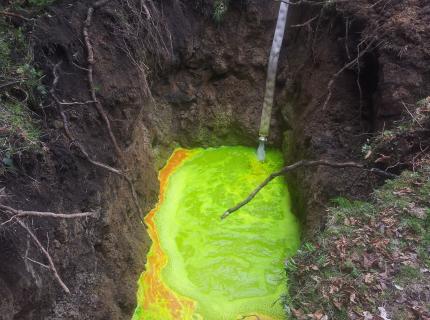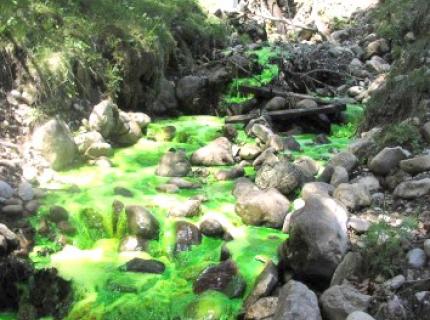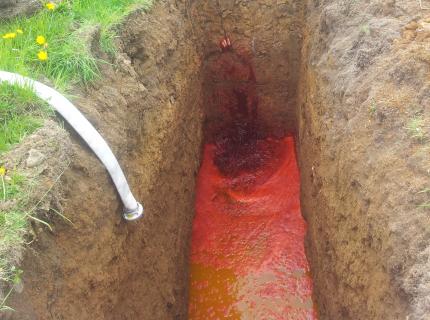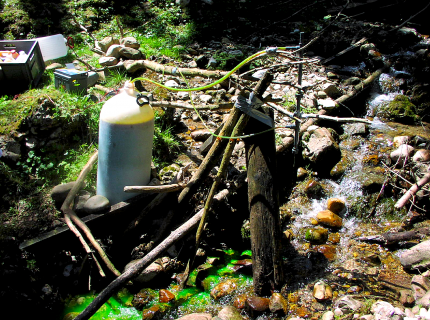



Areas of Work
Tracer tests
Tracer tests serve as detection of flow conjunctions and spreading processes in groundwater as well as the investigation and quantification of reactive transport processes. Hydroisotop GmbH develops individual tracer concepts for ground and surface waters or special applications. Projects that include the complete spectrum of design, implementation, analysis, evaluation, and interpetation are conducted in the following areas:
- Questions regarding water management e.g. exploration of catchment and protection area or exploitation of bank infiltrates
- Determination of hydraulic parameters and flow time in geothermal wells
- Leakage testing in tanks and pipe systems
- Detection possibilites of lake and river infiltrates in groundwater
- Implementation of optic tracer-flow-logs for the differentation of inflow in deep wells (also at very low productivity)
Tracer compounds or combinations are chosen from a wide spread range of fluorescence tracers (dyestuff), salt tracers, gas tracers (e.g. SF6), or isotope tracers (e.g. deuteriated water). The supersensitive measurement is done by spectral fluorometric methods using HPLC, GC or GC-IRMS in the lab or using online-equipment in the field.
When designing and integrating tracer tests further information derived from studies of stable isotopes, hydrochemical composition, and the age of groundwater can be integrated into an overall concept. Time scale investigations of oxygen-18 can be combined very well with tracer tests. A typical application would be the study of river bank infiltrates.
Tracer-flowmeter-measurements in wells can provide information about inflow depths. These depth-dependent flux measurements are often combined with further hydrochemical or pollutant-specific data (e.g. pesticides and nitrate), isotope data (e.g. nitrate isotopes, residence time determination by tritium and krypton-85) in order to ensure an optimal well design or to answer specific questions regarding remedial actions of wells.
For the design of tracer tests and the evaluation mass transport, reaction, and dispersion models are used. This way the injection masses for the tracer tests will be determined and the specific hydraulic parameters can be derived after completion of the test.
Hydroisotop is actively working to further develop tracer methods for new applications like the cartridge of gas tracers (e.g. sulphurhexafluoride). For the investigation of flowing waters the oxygen exchange and light climate are determined by gas and light-intensive tracers.

Beside the regular tracer substance groups (fluorescence tracers or salt) also isotopically marked substances (stable and radioactive substances) can be applied. In practice water enriched with deuterium (D2O) is usualy used for the marking of surface or pore waters.
- D2O is considered as an ideal tracer since the water molecule is marked itself which means there is no chemical difference between the tracer substance and the isotopically common water (1H2O). The tracer substance is not subject to changes by physical, chemical, or biological processes (adsorption, mikriobial degradation, etc.).
- Water enriched with deuterium is totally harmless with respect to human toxicity.
- There are no problems concerning an official approval.
There are a number of tracer substances available for tracer tests. Beside the common fluorescent dye tracers several salts, drifting substances, and isotopes and radioactive substances (in special cases) can be used for marking.
Among the dye tracers the following tracer substances (sorted by suitability and usability) are applied primarily:
- Uranin
- Eosin
- Na-naphthionate
- Pyranin and Sulphorhodamine G
Which tracer suits best is decided on substance pecularities such as detectability, adsorption and degradation tendency, and photosensitivity of the substance. Uranin and Eosin feature the best characteristics based on this decision process.
Regarding the application of the common tracer substances in the environment, especially in groundwater or during the investigations preliminary to a drinking water supply installation, they have been ecotoxicological assessed by the German Federal Environmental Agency (Human- und ökotoxikologische Bewertung von Markierungsmitteln in Gewässern, Bundesgesundheitsblatt, 1997). All of the above listed substances were rated as non-hazardous with respect to their toxicity.




